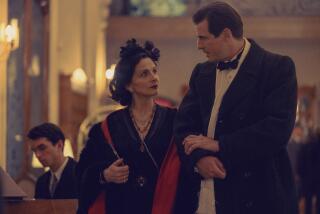In pursuit of the Queen of Speed
“Bugatti QUEEN” is the story of Helle Nice, an attractive and athletic French woman who -- I wish there was a nicer way to say this -- prostituted herself for race cars during her two-decade career as a daredevil driver and competitor in European grand prix racing.
Author Miranda Seymour doesn’t come to this pointed conclusion herself -- her voice is far too prim for that -- though she does note that Nice seems to have slept with nearly every man who let her drive one of his cars. Nice, who died in poverty in 1984, left a trove of photos, around which Seymour bases her narrative as if she were telling the story while leafing through a photo album. One look at some of the ugly mugs Nice took as “lovers” -- particularly during her barnstorming tour of American board tracks in 1930 -- leaves little doubt that she operated on a cars-for-sex basis.
Shocking? Not if you know racing. Money and driving talent are often inversely proportional, and there are always more desperate drivers than there are seats. I’m sure Junior Johnson would have sold himself to get into a decent race car if he could have found a buyer.
In a way, it’s a shame that Seymour -- a British writer of well-regarded biographies of Robert Graves and Henry James -- has chosen to treat her subject’s life with such elegiac delicacy. Steady and graceful, Seymour’s prose is full of admiration for Nice, a showgirl turned driver who raced wheel-to-wheel with immortals like Tazio Nuvolari, Carlo Felice Trossi and Louis Chiron. This admiration, falling as a gentle rain throughout the book, occasionally increases to a downpour and seems to wash some of the more lurid colors from Nice’s biography. I personally like lurid colors.
Born Helene Delangle near Chartres in 1900, Nice began her career as erotic postcard model before taking up nude dancing and ultimately becoming a headlining showgirl at the Casino de Paris, where, hints Seymour, she might have had liaisons with the notorious swain Maurice Chevalier and others. Nice’s racing career rose on several currents. Paris of the late 1920s was car-obsessed, and publicity-hungry manufacturers attached themselves to glamorous show people by letting them drive their cars at amateur races and fashion shows called concours d’elegance (“processions of elegance”). Also, in Europe between the wars, women athletes were honored almost as secular saints, as paragons of a new physical culture, competing against men with a fierce intramuralism that is hard to imagine today. Seymour recalls the case of a latter-day Amazon named Violette Morris, a boxer and javelin thrower who had her breasts removed so she could better drive a race car.
Nice’s move to automobile racing appears to have been prompted by her friendship with Marcel Mongin and Henri de Courcelles, who were partners in an automobile shop in Paris. The trio met in 1920 and in the following years traveled together to races all over Europe. If they weren’t racing cars, they were skiing, sailing and mountaineering -- sporting and disporting in equal measure.
In early 1929, Nice tore some ligaments in her knee while escaping an avalanche at the Megeve ski resort in the French Alps. Nearly 30, the injured dancer understood that her career in the casino’s unforgiving footlights was ending. She decided to race cars. With Mongin’s help (and his Omega Six car), she trained for and won a grand prix race for women in June 1929. In December 1929, she drove a Bugatti 35C to a world record of 198 kilometers an hour (123 mph) over a 10-kilometer course at Montlhery track near Paris. For a week she was, as Seymour says, the most famous woman in France; the press called her La Reine de Vitesse -- the Queen of Speed.
For much of the next decade, Seymour says, Nice “drove on Europe’s most demanding courses and she did her best to drive, without the concession of a handicap, against the best male drivers of the time,” but her racing record was, on balance, only fair. The greatest female driver of her era, by general consent, was Elizabeth Junek, another Bugatti driver. But Nice was gifted, for it was extraordinarily difficult to drive cars like a supercharged Bugatti or an Alfa Romeo -- and frightening.
Nearly a dozen of Nice’s lovers died in racing accidents. She was left for dead after an accident at Brazil’s Sao Paulo Grand Prix in 1936. But a greater disaster occurred after World War II, when, at a party before the 1949 Monte Carlo Rally, French racing legend Louis Chiron accused her of having been a Nazi collaborator.
Seymour is circumspect on Nice’s guilt, noting that Nice and her lover, Arnaldo Binelli, waited out the war at a magnificent estate on a promontory above the city of Nice. Might she have turned informer to secure this residence on the French Riviera? If so, she paid the price. She died in a wretched apartment and was buried in a family plot in Sainte-Mesme near Chartres, her grave left unmarked by her jealous sister. It was only through Seymour’s exceptional legwork that she was able to recover Nice’s scattered letters, photos and clippings, and only through her warm and memorable writing that Nice’s life -- in all its exuberance and carnality -- has been salvaged from oblivion.
More to Read
Sign up for our Book Club newsletter
Get the latest news, events and more from the Los Angeles Times Book Club, and help us get L.A. reading and talking.
You may occasionally receive promotional content from the Los Angeles Times.







